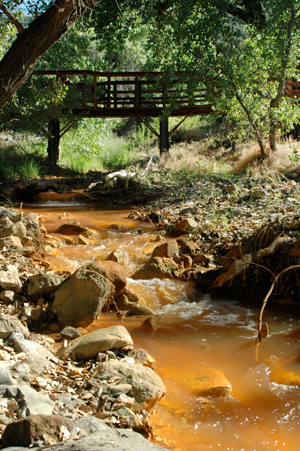
Responsible party steps forward in state’s effort to halt
mercury drainage New Idria mine
It could be considered San Benito’s
”
gift
”
to the rest of the state. Normally a trickle of orange in the
summer, the San Carlos Creek of New Idria is currently rushing
toward the Central Valley during this unusually wet season. But
there’s renewed hope toward cleanup of the toxic mess.
Responsible party steps forward in state’s effort to halt mercury drainage New Idria mine
It could be considered San Benito’s “gift” to the rest of the state.
Normally a trickle of orange in the summer, the San Carlos Creek of New Idria is currently rushing toward the Central Valley during this unusually wet season.
But there’s renewed hope toward cleanup of the toxic mess.
Buckhorn Industries, a company based in Milford, Ohio, has stepped forward as a “partial” responsible party – which is unusual, as many industries fingered in pollution cases normally would perpetuate a state of denial in the matter.
But when Buckhorn officials found out that San Benito County was going to use a $200,000 state “Brownsfield” grant to hire a law firm to identify a responsible party for the mercury pollution pouring from the defunct New Idria mine, they stepped forward,
“They are the same ones found liable at the New Almaden Mine (in San Jose), so they came forward on their own avail,” said the county’s Integrated Waste Management director Mandy Rose, who is charge of implementing the grant. “They said they knew something was going to come, and they went through the same thing at New Almaden.”
Buckhorn is a subsidiary of Myers Industries, and is one of the biggest plastic packaging companies in the nation. They specialize in custom molding for plastic pallets and containers, such as toolboxes and milk carton carriers.
Rose said that Buckhorn didn’t actually own the mercury mine, but instead bought a company that once operated the mine for some five years.
“They aren’t the bad guys, they aren’t the ones that did it,” Rose explained. “They bought the company that did. So they are a successor corporation, but they understand they have some liability.”
Don Thomas, general manager for Buckhorn, did not return phone messages.
Just a week ago, Gov. Arnold Schwarzenegger took a helicopter tour over flooded Firebaugh, in west Fresno County, to see the extent of the damage to local levees. The town lies directly east of Panoche Valley, which is rimmed by Silver Creek, which the San Carlos drains into.
Silver Creek drains into the Mendota Pool, a small reservoir near the town of Mendota, which flows into the San Joaquin River. The San Joaquin eventually drains into the Delta, which flows out into the San Francisco Bay.
Normally San Carlos Creek flows downstream from the New Idria ghost town and mine for about five miles before dissipating and percolating into the ground. The rust color of the water is caused by iron sulfide from the mine, while the more lethal organic species of methylmercury is colorless and odorless, like water. But during the winter and spring, the mercury-riddled waterway rages into a river through the Tumey Hills, and residents in the area have seen cattle from the upper Vallecitos – south of Panoche Valley – drinking from it.
Mercury, if ingested, can “bioaccumulate” in the system and cause nervous disorders in its victims. The early miners of New Idria during its heyday often suffered from “salivation” due to mercury poisoning, in addition to enduring tremors, brain disorders and disrupted motor skills. One drop of methylmercury is enough to kill a person within a month or sooner.
San Carlos Creek is fed by a reservoir near Clear Creek, and the water travels through some 80 miles of honeycombed cinnabar mining tunnels before seeing the light of day below New Idria. The waterway is also fed by runoff over cinnabar tailing piles, which mercury scientist Priya Ganguli of the San Francisco Regional Water Quality Control Board believes is a second cause for the high levels of mercury in it.
Earlier this month, Ganguli and fellow scientist Dr. Khalil Abu-Saba of Santa Cruz traveled to New Idria to document the creek on film, to capture its behavior during the rainy season. They hiked some five miles through a ranch in the Tumey Hills observing how the creek turned into a full blown raging river.
“There is mercury in that creek bed that has been dormant for 50 years, and now it’s getting disturbed by all the water,” Ganguli said, as she observed the San Carlos from a high bluff.
New Idria also got a visit recently from a news crew for KPIX Channel 5, based in San Francisco, who filmed a feature about mercury contamination in the Bay. Last year the Associated Press reported that mercury in marine life from the Bay had spiked, and that higher levels of the toxin had been found in affluent people, presumably because they tend to order a lot of fish dishes in fancy restaurants.
New Idria was the second largest producer of mercury in the western hemisphere during the last century, second only to San Jose New Almaden Mine. Mercury was used mostly in photographic plates and then later in munitions productions for both World Wars. The mine operated from 1856 to 1971, and at its peak in the early 1900s the town supported some 600 workers and their families.
Rose said that Buckhorn officials are working with the Central Valley Regional Water Quality Control Board, an arm of the state Environmental Protection Agency which also has jurisdiction over the San Carlos Creek since it flows east into the Central Valley. Together, the company and the agency are expected to come up with a plan to clean up the cause of the polluted creek – at least partially.
“The regional board is the lead agency on this, not us,” Rose said. “The county doesn’t want to own it or have the liability.”
But Buckhorn will most likely pay for only part of the process, if any. Rose said she doesn’t have any idea when the plan will be finalized, and pointed out that it took 15 years for the company to resolve the cleanup of New Almaden.
Since it has yet to be definitively proven that the San Carlos is a contributor of mercury in the Bay, said Mandy Rose, head of San Benito County’s Integrated Waste Management department., Buckhorn might pay for a study on the matter.
“Maybe they will pay for it,” Rose said. “Then we’ll have the data, rather than just guessing.”









